The digitisation of New Zealand’s research, heritage and culture
Over the last 25 years, it has become possible to digitise and store an ever-increasing amount and variety of material. New Zealand has been one of the leaders in this area, with early initiatives such as the New Zealand Digital Library in the mid-1990s and the more recent Digital Content Strategy promoting the idea of digitising New Zealand’s research, heritage and culture and making it available online. The government is committed to ensuring ‘New Zealand will be a world leader in using information and technology to realise its economic, environmental, social and cultural goals’.1 They see New Zealanders as world leaders in using information and technology to build globally connected science and technology research communities.
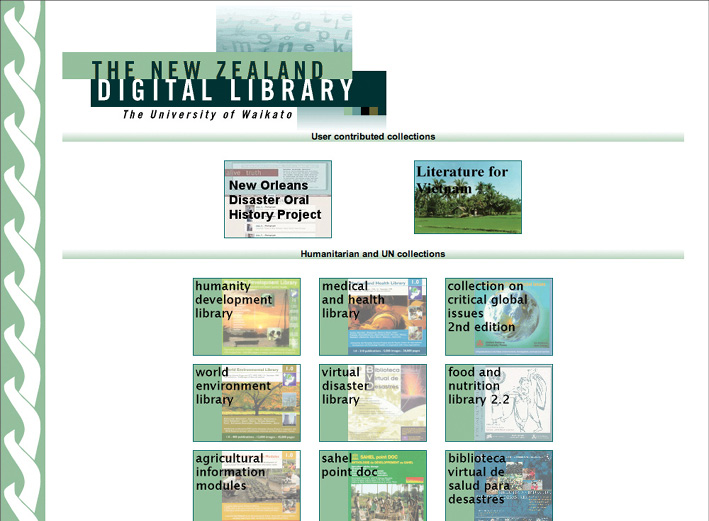
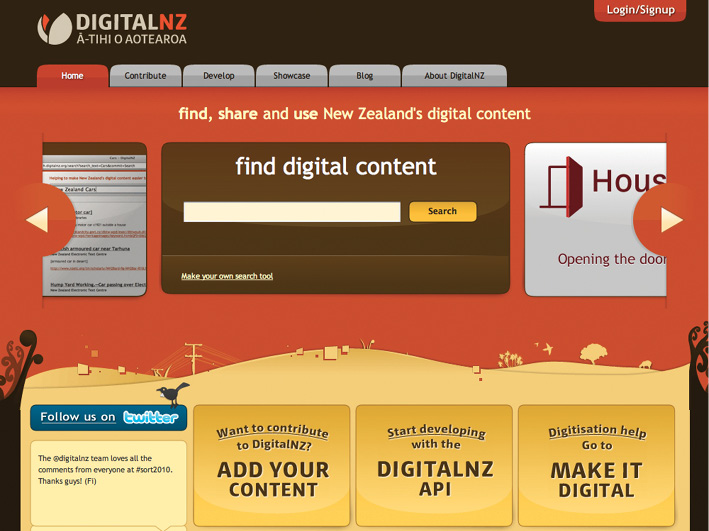
A key benefit of digitising research, cultural and heritage material is improved accessibility. It can be difficult and laborious to find specific items in traditional ‘hard copy’ collections, whereas digital collections can be quickly and easily searched. They can also be made available via the Internet to a much larger audience than was previously possible. Digitisation also removes the access bottleneck arising from there being few physical copies of an item, as many people can access the same digital item simultaneously. Finally, digitisation helps us to preserve fragile historical material by reducing the need for physical access, and hence the likelihood of further physical damage or even loss.
The need to store and manage digital collections of this nature has driven the development of digital libraries and repositories of various kinds, including the aforementioned New Zealand Digital Library. More recently, the launch of the government’s Digital Strategy in 2005 resulted in a nationwide proliferation of digital research repositories at New Zealand tertiary institutions, and ultimately led to the development of the Kiwi Research Information Service (KRIS) by the National Library of New Zealand. These developments have made New Zealand’s research readily available to the wider world.
The same technologies used to build these institutional research repositories are also now being applied in non-academic areas. In 2006, the Cardrona Online Museum was launched, with the aim of storing and making available heritage materials relating to the Cardrona district. The launch attracted strong interest and has led into an ongoing project to develop a similar repository for the Central Otago region. In parallel, the Horowhenua Library Trust and Katipo Communications Ltd, developed the Kete software to facilitate online community collaboration, and recently, the National Library began to harvest and index content from New Zealand websites for its DigitalNZ project.
In this chapter, we will examine these developments, their impact on the dissemination of New Zealand’s research, heritage and culture, and look forward to future developments in this area.
The early days
Project Gutenberg, launched in 1971, was arguably the first digital library in the world, at least in the sense of providing written material in digital form; indexing and discoverability came later as technology advanced in these areas. The project’s aim was to ‘make information, books and other materials available to the general public in forms a vast majority of the computers, programs and people can easily read, use, quote, and search’. They focused on public domain literary and reference works, which were digitised into 7-bit ASCII text to provide maximum portability. They achieved their original goal of 10,000 digitised works in 2001. The library currently contains over 30,000 works, with more being added all the time.
Despite this early start, the limited capacity of available storage devices over the subsequent 20 to 25 years made it difficult to realise a practical digital library. Project Gutenberg itself started with texts of only a few kilobytes. By contrast, the text of a typical 300-page book is about a megabyte (illustrations would increase this considerably), and a modern-day PDF of a technical report with figures typically occupies a few tens to hundreds of kilobytes, depending on the format of the embedded images. It would only take a few thousand of these PDFs — quite a feasible number for a moderately sized tertiary institution — to consume a gigabyte of storage. This may not sound very large by today’s standards, but consider that in 1990 a typical hard drive cost about US$9 per megabyte. A gigabyte of 1990 storage would therefore have cost the better part of US$10,000, which was clearly prohibitive for all but the largest organisations. Fortunately, the capacity of hard drive storage has increased exponentially for many years, doubling roughly every 12 months, with a corresponding exponential drop in cost per unit of storage. The first gigabyte capacity drives appeared in 1995 for about US$800, or about 80c per megabyte. In 2010, a one terabyte drive — 1000 times the capacity! — can be had for just over US$100, or about 0.0001c per megabyte; a drop in cost of almost seven orders of magnitude since 1990.
It is probably no coincidence, then, that the first significant efforts towards building digital libraries coincided with the arrival of relatively cheap, high-volume mass storage devices in the mid-1990s. Several major projects were initiated between 1994 and 1996 at universities across the United States, including Carnegie Mellon, the University of California (Berkeley and Santa Barbara), Stanford, the University of Illinois and the University of Michigan. In New Zealand, the Department of Computer Science at the University of Waikato launched the New Zealand Digital Library (NZDL) project in 1994. The initial aim of the project was modest: to digitally store a collection of New Zealand computer science technical reports, similar to existing US repositories of the time like CS-TR (Computer Science Technical Reports) and arXiV.
The project quickly expanded from this foundation to incorporate other material, and began to develop into a general infrastructure for creating digital libraries of all kinds. Many other collections were added alongside the original computer science collection, including mirrors of Project Gutenberg and the Oxford Text Archive, and the Indigenous Peoples collection. They also expanded from primarily textual documents to incorporate other types of content, such as images, video and music. They also undertook considerable research into techniques for browsing and searching digital library collections, as detailed in the NZDL Publications collection.
The NZDL project culminated in the release of the Greenstone digital library software in 2000. This software provided a construction kit for digital libraries, with an extensible plug-in architecture. Since its release, Greenstone has been used to create many digital libraries around the world.
Today, the original NZDL at Waikato has nearly 60 collections, spanning computing, literature, history, health, education, environment, food and nutrition, social and community development, and cultural heritage. Experiments are being carried out with content in other languages, including Chinese and Arabic. Of particular interest from a New Zealand perspective are the Niupepa collection of historical Māori newspapers published between 1842 and 1932 and the Hamilton Public Library Youth Oral History collection of youth experiences in the 1930s, 1940s and 1950s.
The latter two collections are prime examples of material that would be difficult to find and utilise in non-digital ‘hard copy’ form (e.g. paper, audio tape or film). Traditionally, such collections were stored in hard copy somewhere in the shadowy depths of a library, and access could often only be gained on direct request, effectively requiring potential users of the material to already know that it existed. The library would often have held only one copy, further limiting access to the material. Providing collections in digital form breaks the first constraint by making their contents easily discoverable and indexable by Internet search engines (thus enabling serendipitous discovery without prior knowledge), and by making it accessible from anywhere in the world. It can also break the second constraint by enabling multiple users to access the material simultaneously, or even to make their own digital copies, if permitted.
Putting these two collections into the New Zealand Digital Library has therefore revealed and opened them up to a much broader audience — both domestic and international — than would have otherwise been possible. (Indeed, such collections can be accessed from some surprising places, as we will see when we discuss the Cardrona Online Museum.) These kinds of arguments are also applicable to the outputs from academic research, and form the core of what is known as the open access movement. This movement has driven the construction and adoption of institutional research repositories worldwide, so it is now an opportune moment to look at these developments.
The rise of the institutional repository
The concept of the institutional research repository has its roots in the open access movement. In many ways, open access is to peer-reviewed research outputs what open source is to software; that is, open access literature is ‘digital, online, free of charge, and free of most copyright and licensing restrictions’. In other words, open access removes price barriers such as subscription and licensing fees, and also permission barriers such as copyright and licensing restrictions. This makes research outputs more readily available to those who might not otherwise be able to access them (e.g. due to budgetary constraints); makes publications easier to find (as they are easily searched for and downloaded over the Internet); and broadens the audience beyond the subscription base of a single journal. Of course, open access is not limited to just journal articles; it can be of particular benefit for other types of publication such as conference papers or technical reports, which can sometimes be difficult or even impossible to obtain in printed form.
In order to make research outputs freely available online, we clearly need somewhere to store them: a repository of some sort. Researchers in physics and mathematics realised this very early, and in 1991 founded arXiV, which today contains over half a million articles in physics, mathematics, computer science, quantitative biology, quantitative finance and statistics, all of which are freely available. arXiV is generally considered the first significant open access digital repository, and was a major inspiration for the open access movement that followed it a few years later. During the 1990s several similar repositories were launched, including GenBank in 1992, and Research Papers in Economics (RePec) and PubMed in 1997.
Stevan Harnad effectively laid the groundwork for the modern institutional repository with his ‘subversive proposal’ that researchers should self-archive their research outputs. That is, in addition to publishing them through normal channels, they should also store a freely available digital copy in an online digital repository.1 The intuitive leap Harnad made was to suggest that such repositories could be hosted by the researcher’s institution, hence the term ‘institutional repository’, although at the time, this was hampered by a lack of readily available software for managing such repositories. This lack was ultimately addressed with the release of GNU EPrints by the University of Southampton in 2000 and DSpace by MIT in 2002. These two are the most widely known and used open source packages for managing digital institutional repositories, but there are several other similar open source (e.g. Fedora Commons2) and commercial options (e.g. Digital Commons by The Berkeley Electronic Press).
1 Of course, there are many potential issues with storing copies of published research articles in a repository, not the least of which is copyright. However, these issues are not insurmountable, and have been largely resolved by the open access community. Such considerations, while important, are not directly germane to the current discussion; we encourage readers to explore the literature on open access for further information and guidance.
2 The DSpace Foundation and Fedora Commons merged in May 2009 to form DuraSpace.
The arrival of such a plethora of software options, along with practical solutions to issues such as copyright, has, since about 2004, spurred a rapid growth in the number of institutional repository installations. The Directory of Open Access Repositories (OpenDOAR) started keeping statistics on open access repositories in early 2005 and now lists over 1500 repositories worldwide. The actual installed number of repositories is greater than this, however, as OpenDOAR only lists those repositories that have been reported to it by users; that is, it does not automatically discover new repositories.
Just as the international growth in open access repositories began to gather momentum, the New Zealand government launched its previously mentioned Digital Strategy. In parallel with this, the National Library of New Zealand set up an expert working party with representatives from across the research sector to investigate the feasibility of establishing a national repository for New Zealand’s research outputs. The ultimate intent was to improve access to New Zealand’s research outputs, by collaborating with institutions to stimulate the creation of research repositories.
While these efforts were proceeding, two senior University of Otago staff undertook a study tour of ‘digital challenges’ facing universities in the United States. Their report provided the immediate impetus for a digital repository project within the University’s School of Business. Following discussion with network contacts in the National Library of New Zealand and Australia, the School of Business approved funding for a pilot project. Work began on November 7, 2005, with the goal of building a proof of concept open access repository for the School.
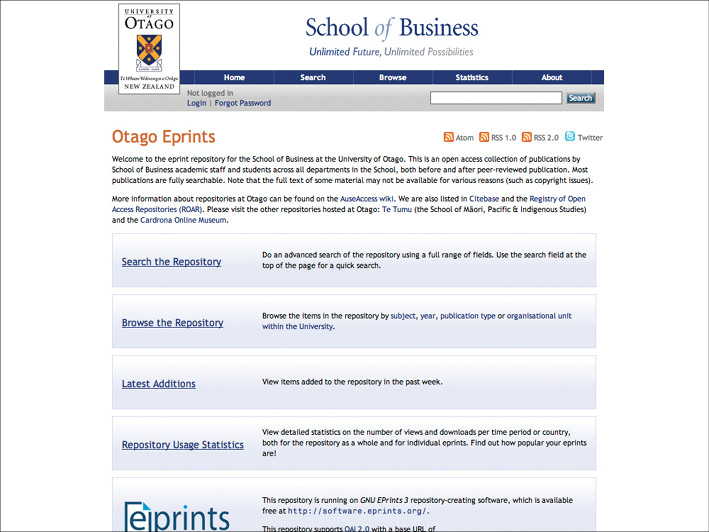
The pilot repository was fully implemented and went live within 10 days of assembling the project team (on November 17, 2005). Unbeknownst to the development team, similar projects were already well advanced at other institutions around the country, but the rapid implementation and straightforward goals of the Otago pilot enabled it to leapfrog the rest of the field to become the first publicly available institutional repository of its type in New Zealand (as acknowledged by Professor Arthur Sale of the University of Tasmania, in his keynote speech at the Institutional Repositories Symposium held by the National Library in Wellington on November 23, 2005). This was possible because of a very clear brief to ‘prove the concept’, rather than getting bogged down in details of architecture, policy and procedure. The prototype was also cheap to build, using the free EPrints software, existing hardware and the equivalent of two full-time staff. The Otago implementation showed that creating a successful digital repository need not be a complex or expensive proposition. Six months after the initial launch of the pilot, and with relatively little modification, it was adopted as the official repository for the School of Business, and remains so to this day.
An exciting outcome of the School of Business repository was the ability to make available material that might otherwise be difficult or impossible to access, and thus increase the likelihood of it being cited. About three-quarters of the 735 items in the repository as of March 2010 are documents that might not otherwise be as readily accessible, such as theses, dissertations, seminars, and departmental working or discussion papers. The full text of most of these items is also indexed and searchable through major Internet search engines such as Google, usually within only a couple of days of being made publicly available. The impact of this is evident: there have been over a quarter of a million document downloads since the repository was launched, with nearly 90% of these originating from 205 other countries.
The success of the pilot also attracted attention from other parts of the University. In early 2006, Te Tumu, Otago’s School of Māori, Pacific and Indigenous Studies, expressed an interest in implementing a repository for their specific needs. They were particularly interested in the use of a digital repository for disseminating their research and other work, as there are relatively few ‘official’ outlets for their discipline. In addition to the usual academic papers, Te Tumu wanted to store multimedia content such as images of traditional crafts and artwork, and video clips of performances. The extensible architecture of EPrints made it simple to cater for these requirements.

Te Tumu repository was implemented in less than a month, and was officially launched on May 3, 2006, becoming the first digital repository for indigenous studies in New Zealand. Interest in the repository is evident with over 54,000 downloads from 134 different countries as of March 2010. The repository currently contains 65 items, including articles, theses, images and videos.
Similar repositories at other tertiary institutions around the country quickly followed those at Otago. Today, all New Zealand universities and many polytechnics have some form of institutional repository, sometimes several. These repositories adopt a broad range of approaches, including:
- Repositories that only accept specific types of research output, e.g. those in the Australasian Digital Theses programme;
- Hosted repositories like coda, which host material from a consortium of tertiary institutions, in order to reduce costs;
- ‘Showcase’ repositories like the Otago University Research Archive, which only include high-quality research outputs, intended to showcase the research output of the institution;
- ‘Working’ repositories like the Otago School of Business repository, which accept a wide range of both quality-assured and non quality-assured research outputs, such as internal discussion papers or technical reports; and
- Repositories relating to a specific subject area, such as Te Tumu repository.
These repositories employ both proprietary (Digital Commons) and open source (DSpace, EPrints) software. Most of the repositories running DSpace are part of a hosted solution developed by the Library Consortium of New Zealand (LCoNZ) and based at the University of Waikato.
2005 and 2006 saw another significant milestone in the development of institutional repositories within New Zealand, when the Tertiary Education Commission announced funding for projects to build institutional repository infrastructure. Three significant projects were funded in this area:
- Coda (mentioned above) produced a hosted repository service for tertiary institutions, based on Digital Commons.
- Institutional Repositories Aotearoa set out to foster the development of a national network of interoperable, open access research repositories. This ultimately led to the successful deployment of institutional repositories at the Universities of Auckland, Canterbury and Waikato.
- Open Access Repositories in New Zealand, shared some goals with Ira, but also aimed to support individual institutional initiatives by building a knowledge base of examples and best practices, thus lowering barriers to entry; and to promote a ‘common road map’ for institutional repositories within New Zealand to encourage institutions to join a national network.
A major spinoff of these projects was the development of the National Library’s Kiwi Research Information Service (KRIS), which was initially launched in January 2008 as the National Research Discovery Service. This is an aggregator that regularly harvests metadata from all New Zealand institutional research repositories, and provides a single search interface. This means that anyone wanting to locate New Zealand research outputs can go to a single location and perform a targeted search across all New Zealand repositories, rather than searching each individually, or relying on a general search engine like Google, which would by default produce a less-focused set of results.
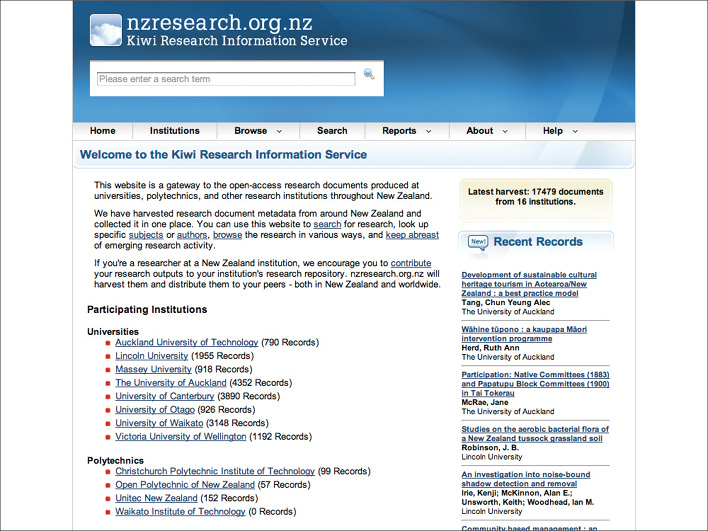
Digital repositories are now well established in New Zealand’s academic sector as a solution for making research outputs publicly accessible. However, this is not the only sector that can benefit from use of digital repositories. Communities have large amounts of historical and heritage material that is often not readily accessible even to those within the community itself, let alone the wider world. A digital repository is an excellent tool for making much of this kind of material available, and there have been several recent and exciting developments in this area in New Zealand.
Community and heritage repositories
For centuries, individuals have collected and preserved all kinds of community and heritage materials, which have provided valuable historical insights into the everyday lives of people around the world. Often these collections and records can have unexpected uses. For example, in a recent study, historical photographs, notebooks and specimens collected and preserved by the public were used to document the environmental effects of increasing temperatures in the Boston area over the previous 100 years.
Many such collections are donated to libraries or museums that have the professional capability to preserve and curate them, but many are also maintained (or neglected) within families or communities. We noted earlier that non-digital collections already suffer from problems of accessibility. Hard copy historical collections housed within libraries and museums are at least accessible to some extent, depending on how fragile or unique they are, but there is very little hope of general accessibility to historical material stored in the community, especially when it is not in digital form.
This has led to the idea of digitising historical material to provide greater access. For example, the UK National Archives digitised the Domesday Book and made it available online. In New Zealand, the National Library launched the Matapihi project in September 2004. This is effectively a cultural analogue of KRIS that provides an aggregated view and search of online collections from several New Zealand cultural organisations, including the Alexander Turnbull Library, Archives New Zealand, the New Zealand Film Archive, Te Papa, the Hocken Library and the Auckland War Memorial Museum. It currently provides online access to over 220,000 items, including images, documents and videos.
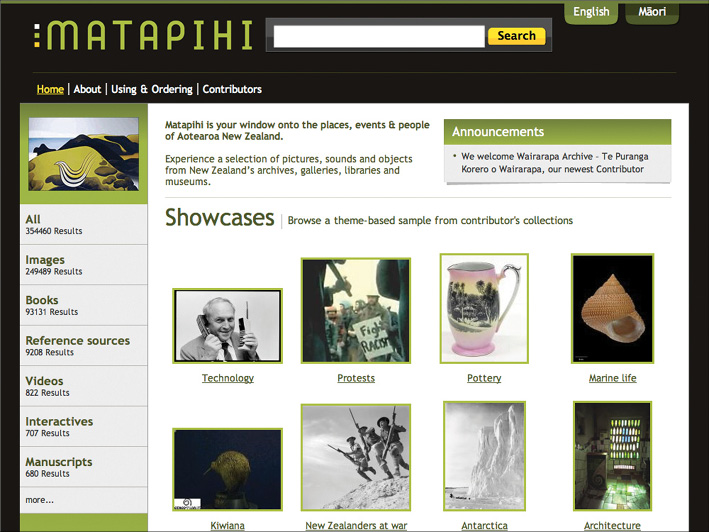
However, such initiatives only address material that is held by larger organisations. There is still a very large corpus of community-held material that needs to be considered. Fortunately, the arrival of high-quality, low-cost scanners and digital cameras means that the cost of digitising and making available historical community material has dropped considerably in recent years. It is now feasible for community groups to consider setting up their own digital heritage archives, such as the Pacific Northwest Olympic Peninsula Community Museum in the United States. Indeed, it was such examples of what could be done that inspired the development of a digital heritage repository for the Cardrona community.
The Cardrona Valley is situated in western Central Otago, stretching 40 km from Wanaka in the northeast to the Crown Range in the southwest. The township of Cardrona was first settled during the gold rush days of the 1860s, quickly growing to a population of 3000. A long decline began once the gold was exhausted, however, reversed only by significant tourism developments in alpine and Nordic skiing during the 1970s and 1980s. Cardrona has subsequently become a major tourist destination, and is once again a thriving community with great potential for future development.
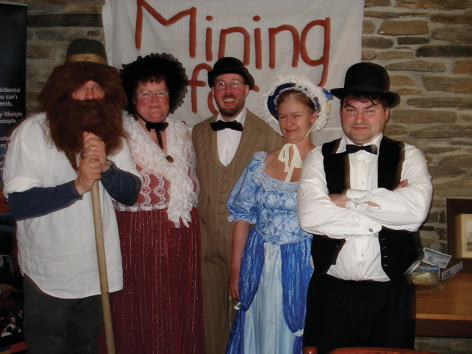
The Cardrona Online Museum team at the Cardrona Vintage Fair, 3 December 2006. From left: Graham McGregor, Monica Barkman, Nigel Stanger, Debbie Laney, Wayne Shilcock.
There is a keen interest in local history amongst Cardrona residents, and in early 2006, the University of Otago School of Business was approached by Cardrona community leaders with the idea of building a community heritage repository to help preserve and disseminate the broad range of historical and heritage material from the district. This approach came about because of the school’s previous successes with building open access research repositories. The Cardrona Community Repository — later renamed to the Cardrona Online Museum — went live on May 17, 2006, hosted at the University of Otago.
The Museum currently contains 35 items, and has proven popular both within New Zealand and internationally, with over 3700 document downloads as of March 2010. The Museum contains an eclectic mixture of historical and contemporary material ranging from the early 1900s onwards. Items include community newsletters, minutes of meetings, locally written articles and discussion documents about the area, newspaper articles, photographs, and oral histories in the form of recorded interviews. One of the latter is the most frequently accessed item in the Museum; accounting for about two-thirds of the total downloads.
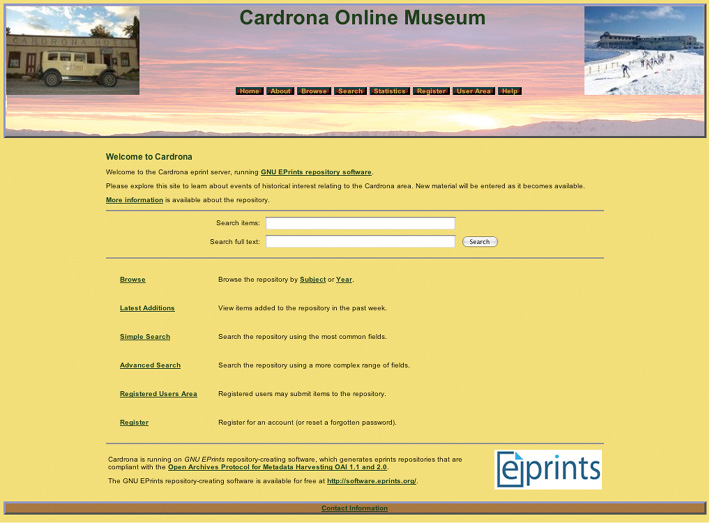
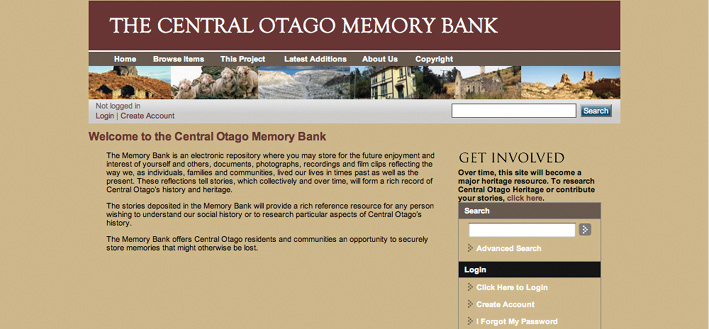

Prototype of the Central Otago Memory Bank.
Analysing document downloads from the Museum reveals some fascinating results. It is no particular surprise that New Zealand accounts for about 60% of all downloads. The United States (12%), Australia (6%) and the United Kingdom (5%) come next, with the remaining 17% spread across 72 countries, including some unexpected ones such as Thailand and Slovakia. We can only speculate as to why people in these countries are accessing the Museum; perhaps they are expatriate locals, or perhaps ‘cardrona’ means something in the local language. In any case, it is clear from these figures that the Museum is doing a good job of disseminating the Cardrona community’s heritage to the wider world.
A particularly interesting aspect of the Cardrona project was a ‘site visit’ by the project team in December 2006. We were invited to participate in the first Cardrona Vintage Fair, which showcased local heritage and crafts. We installed ourselves — dressed in appropriate period costume — in the Cardrona Hotel with a working snapshot of the Museum and a scanner. This enabled us to not only demonstrate the Museum to the public, but also to invite people to bring material for digitisation. Discussions with potential depositors highlighted many issues. Most people had no idea of what would actually happen to material once it was submitted, or even what kind of material would be suitable. We therefore had a broad variety of items offered, ranging from photographs and historical documents through to a shed full of farm machinery! People also expressed the usual concerns about ownership, copyright and privacy of deposited material.
We met with visiting members of the Upper Clutha Historical Records Society. They were extremely interested and very enthusiastic about the possibilities, but noted that the major roadblock for them was cost. The successful repository implementations at the University of Otago showed that there is no need for expensive, high-end hardware or software: a $2000 PC makes a perfectly capable digital repository server, and all the required software is free. However, even this may be beyond the budget of small groups or communities. There are also the ongoing running costs to consider, such as Internet connection, hosting and bandwidth. To be truly effective, a repository would ideally also require a technical administrator, and someone to manage and curate the collection itself, which implies further cost. Clearly, cost will be a significant issue for any community heritage repository.
One solution to this issue is to adopt a similar approach to that taken by the coda project; that is, to develop a hosted solution that individual communities can subscribe to, thus significantly reducing their individual costs. A possible candidate for this is the Central Otago Heritage Memory Bank, which was first proposed in late 2007. Initially targeted at just the St Bathans district, it was quickly realised that it could easily expand to encompass the entire Central Otago region. The Memory Bank is still under development at the time of writing, but the intent is that it will be administered by a trust and run on a central server, thus removing much of the cost burden from communities that wish to participate. However, even should a community decide to ‘go it alone’ — like Cardrona has — and build their own repository, this will not lock them out of participation in the Memory Bank. All digital repository software now supports the Open Archives Initiative Protocol for Metadata Harvesting (OAI-PMH). This means that the Memory Bank can aggregate metadata from any individual Otago community repositories that already exist. This is, in fact, precisely what KRIS already does with New Zealand’s institutional research repositories.
A final initiative to mention here is the Kete project. Kete (Māori for ‘basket’) is open source software that enables communities to collaboratively build their own digital libraries and archives, and has been in active development since 2006. It can store and index most common digital formats, allows users to create links between uploaded documents and provides built-in discussion functionality. Communities can either download and run the software themselves, or can take advantage of a hosted solution provided by the developers, Katipo Communications Ltd. The Kete website (kete.net.nz) lists 17 different sites (including their own) created by various communities and organisations using the software.
We are entering an exciting period for New Zealand’s community heritage. The technology used by New Zealand’s tertiary institutions to build their research repositories is now available to anyone. The combination of cheap hardware, free repository software and inexpensive hosted solutions means that it is now feasible for almost any community or group to create their own heritage repository at little cost. However, this is not the end of the story: there are several exciting ongoing and future developments in this area, which we will now look at.
Current and future developments
One significant issue with all digital repositories is that they tend to store relatively ‘conventional’ types of data: HTML, PDFs, Office documents, JPEGs, etc. This is not because of any technical limitation in the repository software, but rather because these types of data are what people are most familiar with. It may also be harder to come by viewers for some of the more esoteric formats.
The ‘shed full of farm machinery’ mentioned in the previous section is a good case study: how can we get this into a digital repository? It is relatively easy to just digitally photograph everything; a more thorough approach might also document each piece of equipment and store these descriptions alongside the images. This still leaves a significant gap, however, between what is in the repository and the physical reality of the original items. The next step up might be to create interactive panoramic images of each item, enabling repository visitors to view an item from all angles. This requires special equipment, however, and could be expensive. Another alternative could be to create an interactive 3D computer model of each item. This could also be expensive, but until a couple of years ago, models of this nature were even harder to deal with, because they required special software to view them. Auckland-based company, Right Hemisphere, addressed this deficiency by developing 3D viewing software that was licensed by Adobe and embedded into recent versions of Adobe Reader. This means that 3D models of all sorts can now be embedded into a standard PDF, and can be viewed and manipulated in real time by anyone with Adobe Reader. This potentially opens up a whole new range of possibilities for digitising material.
On the academic front, there has been a move in recent years to make the data resulting from research projects more readily accessible. Because such data can come in a huge variety of forms, this implies a need for greater long-term management of research data; something that is regrettably not always considered by researchers at present, especially once the project is completed and the results have been published. The earlier discussion on using community-provided historical material to examine the effects of climate change reveals that any material, including research data sets, may have surprising and unexpected future uses. For example, data collected up to several decades ago by the Department of Preventive and Social Medicine at the University of Otago have been re-used in recent comparative studies that revealed many new insights. Research data management is becoming a major issue internationally, with many US funding bodies now requiring applicants to submit a detailed data management plan. The US, UK and Australia are all well ahead in this area, with significant government-funded initiatives now coming to fruition. Similar work has really only just begun in New Zealand, so there is some distance to make up. This is necessary work, however: the Ministry of Fisheries already requires funding applicants to include a data management plan, and there are anecdotal reports that both the Health Research Council and the Lottery Grants Board are also considering this.
The most recent digital initiative from the National Library is DigitalNZ, which came online during 2009. DigitalNZ aims to help with all phases of the ‘digital content life cycle’, from initial digitisation through to long-term preservation of digital assets, but a key goal is to provide for all New Zealand digital content what KRIS and Matapihi already provide for research and cultural information, respectively. That is, to provide a single portal for easily locating any New Zealand digital content. The existing interoperability infrastructure provided by KRIS, Matapihi and others meant that with relatively little effort, DigitalNZ was quickly able to index all of New Zealand’s research repositories, and also most of its major cultural organisations. This ‘just’ leaves the task of harvesting and indexing the considerable amount of material that exists in other repositories (such as community repositories), and on numerous New Zealand-related websites. While this is well underway, there is still some way to go: a search for ‘Cardrona Online Museum’ in DigitalNZ returned no results at the time of writing.
The government is not sitting idly by while all this is happening. The 2005 Digital Strategy provided funding for many initiatives, including the Digital Content Strategy (of which KRIS and DigitalNZ are products), a cultural portal, an online Encyclopedia of New Zealand, Te Ara, Matapihi, and a National Digital Heritage Archive. Many of these are ongoing projects with planned timelines and funding that run for several years yet. Version 2.0 of the Strategy, which was released in 2008, adds a Digital Continuity Strategy that covers the maintenance and archiving of electronic public records.
Conclusion
It is clear that in only a few short years New Zealand has taken great strides in making its research, heritage and culture available online, and has been a world leader in areas such as digital libraries. New Zealand’s research outputs are now more widely visible than ever before, and the same is rapidly becoming true of a significant amount of its cultural material. Ongoing developments in the area of community repositories will soon do the same for a considerable amount of New Zealand’s heritage that is currently hidden.
We are not resting on our laurels, however; new initiatives are in train that build on previously developed infrastructure. Projects like DigitalNZ take advantage of the considerable work already achieved in creating and linking research and cultural repositories, and will in turn form the basis of even more exciting future developments. The government is keenly promoting digital developments of all kinds, as these provide an obvious solution to the problem of New Zealand’s geographic isolation.
We can therefore confidently say (with apologies to Walt Kelly3): ‘New Zealand has met the future and it is Digital.’
3 From ‘We have met the enemy and he is us’, stated by the cartoon character Pogo in a poster created by Walt Kelly for Earth Day 1971.
is a lecturer in the Department of Information Science at the University of Otago School of Business, where he teaches in the areas of systems analysis and database systems. His first contact with computers at high school in 1981 led him to study computer science at Otago, where he gained a BSc and MSc. He joined Information Science in 1989 as a tutor, progressing to a full lecturing position in 1994. He gained his PhD in 2000.
Dr Stanger has active research interests in digital repositories, distributed and web database systems, XML technologies, physical database design, research data management and database performance. He was the project leader and programmer for the School of Business EPrints repository, which he continues to maintain and enhance. He also assisted with the design and development of Te Tumu repository and the Cardrona Online Museum, and is currently building the prototype for the Central Otago Heritage Memory Bank. He is a member of the Otago University Research Archive advisory group, the Otago Health Sciences Data Management Group and the steering committee for the OARiNZ project, and is leading a research project investigating research data management at Otago. He has been a member of NZCS since 2000, and served on the Otago branch committee from 2007–09 (with one year as branch secretary).
References
alts.net (2008). Historical notes about the cost of hard drive storage space. Retrieved 29 November 2009, from www.alts.net/ns1625/winchest.html
arVix (n.d.). Retrieved 25 May 2010, from arxiv.org
Bailey, CW (2008). Scholarly electronic publishing bibliography: 2007 annual edition. Retrieved 29 November 2009, from www.digital-scholarship.org/sepb/annual/sepb2007.pdf
Cardrona Community Repository (n.d.). Retrieved 15 May 2010, from cardrona.eprints.otago.ac.nz
Coda (n.d.). Retrieved 25 May 2010, from www.coda.ac.nz
Cook, M (2006, 7 August). IT offers opportunities for rural workers, Otago Daily Times, p. 11
Digital Content Strategy (n.d.). Retrieved 25 May 2010, from www.digital.content.govt.nz
DigitalNZ (n.d.). Retrieved 25 May 2010, from www.digitalnz.org.nz
Downs, J (2009). Hamilton City Libraries 1980–2009: A brief history. Working draft (October). Retrieved 12 March 2010, from ketehamilton.peoplesnetworknz.info/hamilton_heritage/documents/show/70-hamilton-city-libraries-1980-2009-a-brief-history-working-draft-oct-2009
DuraSpace (n.d.). Retrieved 25 May 2010, from duraspace.org
Hajjem, C, Harnad, S & Gingras, Y (2005). Ten-year cross-disciplinary comparison of the growth of open access and how it increases research citation impact. IEEE Data Engineering Bulletin, 28(4), 39–46
Harnad, S (1995). A subversive proposal. Scholarly journals at the crossroads; A subversive proposal for electronic publishing. Retrieved 11 December 2009, from eprints.utas.edu.au/204/
Harnad, S (2005). Australia is not maximising the return on its research investment. Retrieved 7 December 2009, from eprints.utas.edu.au/204/
Hart, M (1992). Gutenberg: The history and philosophy of project Gutenberg. Retrieved 28 November 2009, from www.gutenberg.org/wiki/Gutenberg:The_History_and_Philosophy_of_Project_Gutenberg_by_Michael_Hart
IEC (2008). International Standard IEC 80000-13:2008 Quantities and units — Part 13: Information science and technology. Geneva: International Electrotechnical Commission
IRA (n.d.). Institutional Repository Aotearoa. Retrieved 25 May 2010, from www.ira.auckland.ac.nz
Katipo (n.d.). Kete open source digital library & archiving. Retrieved 10 December 2009, from katipo.co.nz/solutions/kete.html
Keegan, TT, Apperley, MD, Cunningham, SJ & Witten, IH (2001). The Niupepa collection: Opening the blinds on a window to the past. Paper presented at the International Cultural Heritage Informatics Meeting: Cultural Heritage and Technologies in the Third Millennium, Milan
Kete project. Retrieved 25 May 2010, from kete.net.nz
KRIS (n.d.). Kiwi research information service. Retrieved 25 May 2010, from nzresearch.org.nz
Lee, JA (1992). The block mountains of Otago: Changing faces of our greatest natural asset. Retrieved 28 November 2009, from cardrona.eprints.otago.ac.nz/4
Matapihi (n.d.). Retrieved 25 May 2010, from www.matapihi.org.nz
McNab, RJ, Smith, LA, Bainbridge, D & Witten, IH (1997). The New Zealand digital library MELody inDEX. Retrieved 12 March 2010, from www.dlib.org/dlib/may97/meldex/05witten.html
Miller-Rushing, AJ, Primack, RB, Primack, DP & Mukunda, S (2006). Photographs and herbarium specimens as tools to document phenological changes in response to global warming. American Journal of Botany, 93(11), 1667–1674
Ministry of Fisheries (2009). Research documentation: Submission information and instructions. Retrieved 12 March 2010, from www.fish.govt.nz/en-nz/Research+Services/Research+Documentation/Submission+Information.htm
New Zealand Government (2005). The digital strategy: Creating our digital future. Retrieved 12 March 2010, from www.digitalstrategy.govt.nz/Resources/Publications/The-Digital-Strategy
New Zealand Government (2008). The digital strategy 2.0: Smarter through digital. Retrieved 12 March 2010, from www.digitalstrategy.govt.nz/Resources/Publications/Digital-Strategy-20
NZDL (n.d.). New Zealand Digital Library. Retrieved 25 May 2010, from www.nzdl.org
OAI-PMH (n.d.). Open archives intiative protocol for metadata harvesting. Retrieved 25 May 2010, from www.openarchives.org/pmh/
OARiNZ (n.d.). Open access repositories in New Zealand. Retrieved 25 May 2010, from www.opendoar.org
OpenDOAR (n.d.). Directory of open access repositories. Retrieved 15 May 2010, from www.opendoar.org
Otago School of Business Digital repository (n.d.). Retrieved 25 May 2010, from www.opendoar.org
Otago University Research Archive (n.d.). Retrieved 25 May 2010, from ourarchive.otago.ac.nz
Pacific Northwest Peninsula Community Museum (n.d.). Retrieved 25 May 2010, from www.communitymuseum.org
Rankin, J (2005). Institional repositories for the research sector. Feasibility study. Retrieved 28 November 2009, from wiki.tertiary.govt.nz/~InstitutionalRepositories/Main/ReportOfFindings
Right Hemisphere (n.d.). Retrieved 25 May 2010, from www.righthemisphere.com
Scurr, G & Williams, C (2006). George Scurr — Interview 1
Stanger, N & McGregor, G (2006). Hitting the ground running: Building New Zealand’s first publicly available institutional repository, from eprints.otago.ac.nz/274/
Stanger, N & McGregor, G (2007). EPrints makes its mark. OCLC Systems and Services, 23(2), 133–141
Suber, P (2007). Open access overview. Retrieved 29 November 2009, from www.earlham.edu/~peters/fos/overview.htm
—— (2009a). Timeline of the open access movement: Timeline 2000. Retrieved 12 March 2010, from oad.simmons.edu/oadwiki/Timeline_2000
—— (2009b). Timeline of the open access movement: Timeline 2002. Retrieved 12 March 2010, from oad.simmons.edu/oadwiki/Timeline_2002
—— (2009c). Timeline of the open access movement: Timeline before 2000. Retrieved 12 March 2010, from oad.simmons.edu/oadwiki/Timeline_before_2000
Te Ara (n.d.). Retrieved 25 May 2010, from www.teara.govt.nz
Te Tumu Repository (n.d.). Retrieved 25 May 2010, from www.teara.govt.nz
UK National Archives (n.d.). Domesday book project. Retrieved 25 May 2010, from nationalarchives.gov.uk
Witten, IH (2003). Exaples of practical digital libraries: Collections built internationally using Greenstone. D-Lib Magazine, 9, 1–19
Witten, IH, Bainbridge, D & Boddie, SJ (2001). Greenstone: Open-source DL software. Communications of the CAM, 44(5), 47
Witten, IH, Bainbridge, D, Paynter, GW & Boddie, SJ (2002). The Greenstone plugin architecture. Paper presented at the Second ACM/IEEE Joint Conference on Digital Libraries, Portland
Witten, IH, Cunningham, SJ & Apperley, MD (1996). The New Zealand digital library project. New Zealand Libraries, 48(8), 146–152
Witten, IH, Cunningham, SJ, Vallabh, M & Bell, TC (1995). A New Zealand digital library for computer science research. Paper presented at the Second Annual Conference on the Theory and Practice of Digital Libraries, Austin, Texas
Witten, IH & McNab, RJ (1997). The New Zealand digital library: Collections and experience. The Electronic Library, 15(6), 495–504
Witten, IH, McNab, RJ, Boddie, SJ & Bainbridge, D (2000). Greenstone: A comprehensive open-source digital library software system. Paper presented at the Fifth ACM Conference on Digital Libraries, San Antonio